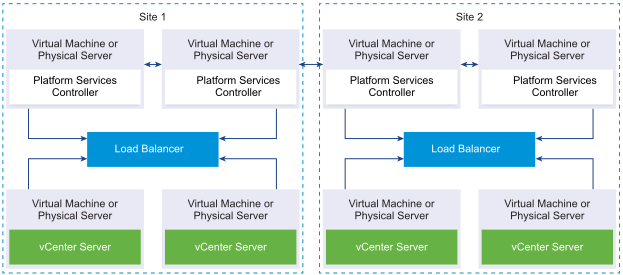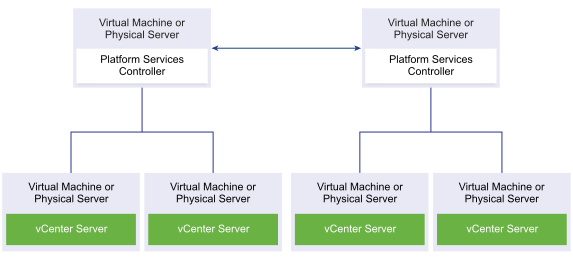To ensure Platform Services Controller high availability in external deployments, you must install or deploy at least two joined Platform Services Controller instances in your vCenter Single Sign-On domain. When you use a third-party load balancer, you can ensure an automatic failover without downtime.
Platform Services Controller with a Load Balancer

You can use a third-party load balancer per site to configure Platform Services Controller high availability with automatic failover for this site. For information about the maximum number of Platform Services Controller instances behind a load balancer, see the Configuration Maximums documentation.
The vCenter Server instances are connected to the load balancer. When a Platform Services Controller instance stops responding, the load balancer automatically distributes the load among the other functional Platform Services Controller instances without downtime.
Platform Services Controller with Load Balancers Across vCenter Single Sign-On Sites

Your vCenter Single Sign-On domain might span multiple sites. To ensure Platform Services Controller high availability with automatic failover throughout the domain, you must configure a separate load balancer in each site.
Platform Services Controller with No Load Balancer

When you join two or more Platform Services Controller instances in the same site with no load balancer, you configure Platform Services Controller high availability with a manual failover for this site.
When a Platform Services Controller instance stops responding, you must manually fail over the vCenter Server instances that are registered to it. You fail over the instances by repointing them to other functional Platform Services Controller instances within the same site. See Repoint vCenter Server to Another External Platform Services Controller in the Same Domain.
Platform Services Controller with No Load Balancer Across vCenter Single Sign-On Sites

Your vCenter Single Sign-On domain might span multiple sites. When no load balancer is available, you can manually repoint vCenter Server from a failed to a functional Platform Services Controller within the same site. See Repoint vCenter Server to Another External Platform Services Controller in the Same Domain.